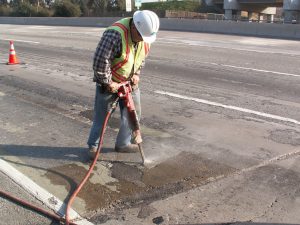Pavement Repairs
Slab Stabilization: Roads can become distressed, losing serviceability and support because there are spaces beneath concrete pavement slabs. These spaces are normally located around cracks or joints as a result of surface water that seeps into the pavement. Generally, voids are caused by pumping, subgrade failure, bridge approach failure, and consolidation. Slab stabilization solves the void issue without being destructive and is normally implemented in tandem with other concrete pavement restoration methods like diamond grinding or patching. This method fills the small spaces that are created underneath the concrete slabs and so restores support. A cementious grout or polyurethane mixture is pumped into holes that are cored throughout the slab. The grout not only fills in the spaces underneath the slab, but also removes free water and continues to keep water from weakening the support once the slab stabilization has been completed. This process takes three basic steps once the voids have been found: drill holes, pump the slab with grout, and test the slabs post-stabilization.
Dowel Bar Retrofit: Dowel Bar Retrofit is a method of pavement repair that helps to re-establish a pavement’s load transfer integrity by placing steel, epoxy-coated dowels into already existing concrete across joints and cracks. The concrete is cut using a diamond-tipped blade and slots are created. IPCC is uniquely qualified with equipment, expertise and know-how to perform dowel bar retrofit application requirements.
Crack Sealing: Cracking in pavement occurs when a stress is built up in the surface layer that exceeds the tensile or shear strength of the pavement causing a fissure or crack to open. Crack sealing and crack filling are methods which can be used to repair these cracks in pavement surfaces. IPCC has applicated all forms of approved sealants including Single and Two Component Silicone and Hot Applied sealants.
